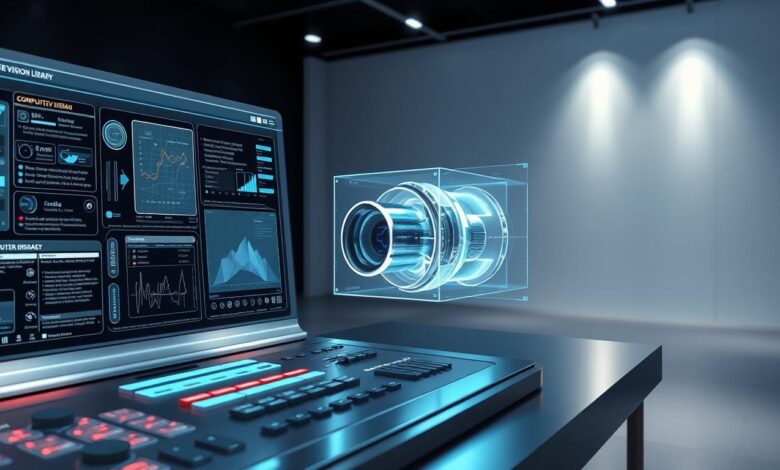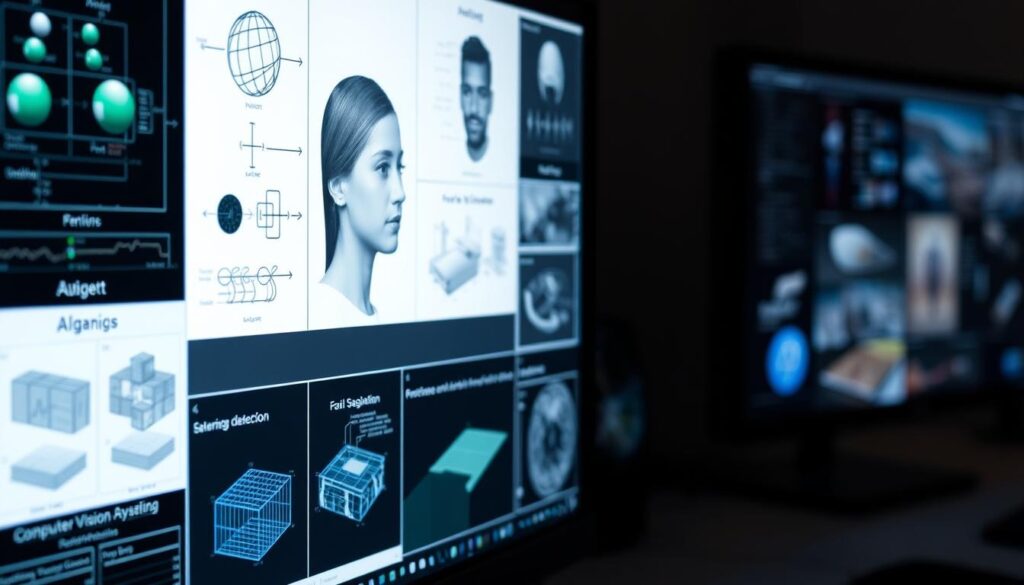What Are Computer Vision Libraries and How Do They Work?

Computer vision libraries are advanced tools that change how we process digital images. They help developers make smart apps that can understand and analyze visual data very well.
These libraries use machine learning to get insights from images and videos. They make complex tasks easy by offering pre-made functions. These functions can spot objects, find patterns, and make smart choices based on what they see.
Today’s computer vision libraries use advanced neural networks for fast and accurate analysis. They can do things like facial recognition, object detection, and semantic segmentation very well.
Developers in many fields use these libraries to make new technologies. They work on self-driving cars, medical imaging, security systems, and augmented reality. The quick and accurate processing of visual data has changed how technology sees the world.
From OpenCV to big tech frameworks, computer vision libraries keep improving. They are changing how machines see and understand our world.
Understanding the Fundamentals of Computer Vision

Computer vision is a leading field in artificial intelligence. It lets machines understand and interpret visual information. This field uses advanced techniques to turn complex visual data into useful insights.
Visual data processing is a detailed process. Machines first capture digital images. Then, they analyze each pixel to find edges, shapes, colors, and textures.
Advanced algorithms help computers learn from these images. This learning is similar to how our brains process visual information. Machine learning models are key in training systems to spot objects, faces, and complex patterns accurately.
Computer vision includes feature detection, pattern recognition, and machine learning algorithms. These technologies help computers understand images, detect objects, and classify content. They make decisions based on what they see. This technology is used in facial recognition and self-driving cars, changing how machines see the world.
Researchers and developers use special libraries and frameworks for these tasks. These tools offer pre-built algorithms and functions. They make it easier to teach machines to see and understand their surroundings.
Computer Vision Library: Essential Components and Features
Computer vision library is a powerful tool that uses advanced image processing algorithms. They turn digital visual data into useful insights. These libraries have complex parts that analyze and understand visual information very well.
At the heart of these libraries are advanced image processing algorithms. They help recognize complex visual information. Object detection technologies identify and classify different parts of an image. This lets developers create smart systems that quickly understand visual information.
Feature extraction is another key part of computer vision libraries. It helps systems find specific details in visual data. This way, they can analyze more deeply. Machine learning models use these details to spot patterns, classify objects, and make smart choices based on what they see.
Today’s computer vision libraries use many different techniques. They mix math models, neural networks, and advanced filters to handle visual data. These libraries help developers make smart apps in many fields, like medical imaging and self-driving cars.
These libraries are very flexible and important for researchers and developers. They offer strong frameworks for analyzing images. This helps push the limits of what technology can do.
Popular Computer Vision Libraries in Modern Development
Computer vision frameworks have changed how developers work with images and videos. OpenCV is a leader, offering strong tools for real-time image processing and machine learning. It has a wide range of algorithms, making it a top choice for complex visual recognition projects.
TensorFlow, from Google, is known for its deep learning skills in computer vision. It’s loved by researchers and developers for its ability to build neural networks. These networks are great for tasks like image classification and object detection.
PyTorch is another key player in computer vision. It was made by Facebook’s AI Research lab. PyTorch is known for its dynamic computational graphs, making it easier to develop models. It’s perfect for research, offering tools for new computer vision techniques.
Each library has its own strengths. OpenCV is great for image processing, TensorFlow for deep learning, and PyTorch for research. Developers can pick the best library for their project, based on their needs and goals.
Core Functions and Algorithms in Vision Libraries
Computer vision libraries unlock powerful capabilities through sophisticated algorithms. These algorithms transform digital images into meaningful insights. Image segmentation is at the heart of these technologies, breaking down complex visual data into distinct regions for precise analysis.
This technique allows computers to understand and categorize different elements within an image with remarkable accuracy. Edge detection is another critical algorithm in vision libraries. It identifies boundaries between different color and intensity regions.
This method helps computers recognize shapes and objects with incredible detail. Researchers and developers use edge detection to extract critical structural information from visual data. This enables advanced image processing techniques.
Facial recognition emerges as a groundbreaking application of computer vision algorithms. These sophisticated functions can map facial features, compare characteristics, and identify individuals across various contexts. From security systems to personalized user experiences, facial recognition technologies continue to revolutionize multiple industries.
Modern vision libraries integrate these core functions seamlessly. They create robust frameworks that can handle complex image understanding tasks. Developers can leverage these advanced algorithms to build intelligent systems capable of interpreting visual information with unprecedented precision and speed.
Image Processing and Recognition Techniques
Computer vision libraries change how we analyze visual data with advanced techniques. Image enhancement is key in getting visual data ready for detailed analysis. It makes images clearer by adjusting contrast, removing noise, and sharpening details.
Object classification is a big deal in deep learning. Neural networks can now spot and sort objects with great accuracy. They learn from huge datasets, helping computers see complex patterns in images, from medical scans to self-driving car tech.
Deep learning has made image recognition much better. Convolutional neural networks can spot details that old algorithms miss. Researchers keep making these models smarter, so they understand images better than ever before.
Today’s computer vision libraries use many techniques together. They combine image enhancement, object classification, and deep learning to make smart systems. These systems can pull out important insights from images in many fields.
Real-world Applications of Vision Libraries
Computer vision libraries have changed many industries with new tech solutions. They are key in making self-driving cars work. These cars use special vision libraries to see the road, find obstacles, and spot traffic lights.
In medicine, these libraries are also making a big difference. Doctors use them to find small problems in scans. They also help in security and unlocking devices.
The car world has seen a lot of progress thanks to computer vision. Self-driving cars use these libraries to understand the road and make quick decisions. They look at thousands of things every second.
Researchers and tech companies are always finding new ways to use computer vision. It’s changing how we use technology, from health to transportation. The future looks bright with even more possibilities.
Implementation Challenges and Solutions
Developers face many challenges when using computer vision libraries. They need to optimize performance when dealing with complex visual data. Using efficient algorithms and streamlined code helps manage this.
Hardware limitations can be a big problem in computer vision projects. Modern libraries need a lot of power for tasks like image recognition. Developers must pick the right hardware to meet project needs. Cloud-based solutions and distributed computing can help with hardware issues.
Data quality is key to successful computer vision projects. Raw images often have problems like noise and missing info. Techniques like data augmentation and noise reduction improve data quality. Using strong validation mechanisms also helps train better models.
Practical solutions include using optimized libraries like OpenCV and TensorFlow. These libraries offer performance boosts. Developers can also use model compression and parallel processing to solve computational problems.
Understanding and tackling challenges is crucial for creating reliable computer vision solutions. By knowing the obstacles and using the right strategies, teams can build advanced visual recognition systems.
Best Practices for Using Computer Vision Libraries
Creating strong computer vision projects needs a smart plan. Developers should aim for efficient library use to boost performance. Using smart techniques can make code run faster and handle complex tasks better.
Good documentation is key to using computer vision libraries well. It helps developers grasp how to use the library and solve problems. Clear guides also keep coding standards high and help team members learn from each other.
Version control is crucial for managing computer vision projects. Git repositories help track changes and let teams work together smoothly. They also keep a record of project history, avoiding code conflicts and making it easy to add new features.
Performance profiling is vital when using computer vision libraries. Developers should check how code runs, find slow parts, and manage memory well. Tools like Python’s cProfile can spot issues early and help improve code.
Choosing the right computer vision library is important. Look at community support, documentation, performance, and compatibility. Libraries with active open-source support often offer the best solutions for vision tasks.
Future Trends in Computer Vision Technology
The world of computer vision is changing fast. New technologies are making machines see and understand like never before. AI is leading the way, making machines smarter at looking at pictures and videos.
Researchers are working on 3D vision to help machines see in three dimensions. This means they can understand space better. Now, computer vision can give us answers right away, in real-time.
This is changing how we use technology in many areas. For example, self-driving cars and medical tools are getting smarter. Machines are learning to see and understand on their own, without needing us to teach them.
Soon, computer vision will be even more advanced. It will be able to spot complex patterns and make smart choices. This is thanks to AI, better 3D vision, and faster processing.
Healthcare, cars, security, and factories will all see big improvements. As computer vision gets better, we’ll have more accurate and efficient ways to use technology. This will change how we interact with the world around us.
Getting Started with Vision Libraries
Starting with computer vision can seem daunting. Choosing the right library is key for beginners. OpenCV and TensorFlow are great for those new to image processing and machine learning.
Setting up your development environment is important. Python is the top choice for vision libraries. First, install Python, then use pip to get the libraries you need. Anaconda makes managing libraries easier and saves time.
Beginner projects are essential for learning. Try simple tasks like image filtering or face detection. These projects help you gain hands-on experience and build confidence.
For learning, check out official guides, online tutorials, and GitHub. Coding challenges can turn theory into practice. Keep practicing and trying new things to improve your skills.
Learning computer vision takes time and effort. Focus on improving slowly, break down big problems, and stay curious. This field is always changing, so keep up with new developments.
Conclusion
Computer vision libraries are changing how we develop software and innovate technology. They let developers make smart systems that understand and see things very well. This is a big deal for making our world smarter.
For those into computer vision, learning never stops. As tech gets better, keeping up with new tools and ideas is key. The future looks bright, with big steps forward in self-driving cars, medical scans, and virtual reality.
Thanks to new tech, computer vision is getting better fast. Tools like OpenCV and deep learning frameworks help developers make systems that can see and understand. It’s a chance to solve big problems in many fields.
Getting into computer vision is more than just learning tech. It’s about making a difference with your work. By always learning and being curious, you can lead the way in this exciting field.




